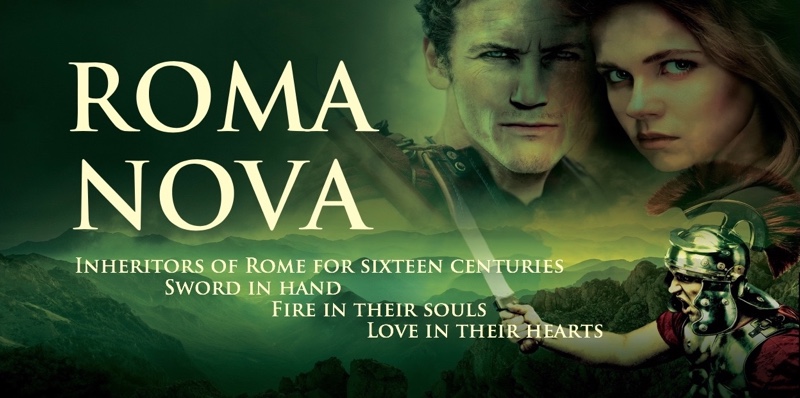Now I’m going back in time to AD 370…
The Roma Nova series has two main strands: one with four books set in the 21st century featuring Carina Mitela and the other set between the late 1960s to early 1980s featuring Aurelia Mitela. The short story collection ROMA NOVA EXTRA includes a couple of stories about the foundation of Roma Nova – The Girl from the Market and Victory Speaks – but these were mere dips into the late fourth century.
Readers have been urging me to write about how Roma Nova started. Every country has a history and in the books so far the characters refer back to that history. I wrote The Girl from the Market after a suggestion from readers. Legend had it (in the earlier Roma Nova novels) that in AD 370 Julia Bacausa, a tough and independently-minded woman and Apulius a strong Roman of the traditional sort met in an encounter full of conflict, but also passion. I loaded in his arrogance and her pigheadedness and independence and The Girl was written.
But he was smarting from arbitrary dismissal from a glittering career path and she was suffering from her uncertain status as a ‘half-divorced’ woman.
It isn’t a 21st century politically correct story; it’s set in the late Roman Empire full of culture clash and religious conflict, but writing the full story now gives the opportunity to expand and enhance the pared down account in the original short story.
And readers want to know what happened in the succeeding decades… 😉
Oh, but the research! The Roman Empire in the late fourth century is a very different one from the one Augustus created in the first.
We know founders Julia Bacausa and Lucius Apulius will survive – there would be no present day Roma Nova if they hadn’t – but the intrigue, I hope, is how and why they did what they did, whether they acted well or not, and what gains and sacrifices occurred. And what the consequences were for Aurelia’s and Carina’s generations.
As I write, I’m about 11,000 words in and I start with the bones of the story in The Girl from the Market, but from Julia’s point of view rather than Apulius’s. That’s an interesting challenge in itself! The other big challenge is all the research. I have a reasonable grounding in Ancient Roman life, but as we know, Rome in the West lasted 1229 years and by AD 370, it was rather different from the classical period of Augustus. And we’re in Roman Noricum, an important province but very different from the old urbs of Rome and the new capital of Constantinople.
As for the setting, the story starts in Virunum, real Roman town in Noricum, now in the Zollfeld north east of Klagenfurt, Austria – more here. Then we move to Rome itself and afterwards the area that will become known as Roma Nova. There’s more here and here about what it may look like.
A little more about the characters in a short while…
This is an adaptation of posts I’ve written for the daily, wide-ranging Writing Challenge over on my writing blog.
Alison Morton is the author of Roma Nova thrillers – INCEPTIO, PERFIDITAS, SUCCESSIO, AURELIA, INSURRECTIO and RETALIO. CARINA, a novella, and ROMA NOVA EXTRA, a collection of short stories, are now available. Audiobooks are available for four of the series. NEXUS, an Aurelia Mitela novella, is now out.
Find out more about Roma Nova, its origins, stories and heroines… Download ‘Welcome to Roma Nova’, a FREE eBook, as a thank you gift when you sign up to Alison’s monthly email newsletter. You’ll also be first to know about Roma Nova news and book progress before everybody else, and take part in giveaways.
















Write faster! By the way, for your own reading you might look at Turtledove and Tarr’s Household Gods. I particularly like it because it’s post Augustinian Roman Empire and is incredibly accurate about things like fleas, dirt, food and just how dirty the Roman Baths really were. It might help give you source material for this book.
Haha! I am trying my best. I remember reading Household Gods years ago when it came out. Quite a lot of the details were vivid and completely credible for the late second century, but I remember finding the characterisation irritatingly two dimensional and really only there to illustrate the setting.
AD 370 is two hundred years on and quite a different environment.
Currently, I’m using Géza Alfödy’s Noricum which is the definitive work on that province, a good printed primary source, Halsall’s Barbarian Migrations and the Roman West, 376-568, Bryan Ward Perkins’ The Fall of Rome, Brown’s The World of Late Antiquity and Gillian Clark’s Women in Late Antiquity.
As for the story? That’s fiction with a chunk of historical speculation. 😉
I am looking forward to it!
[…] http://www.alison-morton.com/2020/08/31/the-next-full-length-roma-nova-story/ […]